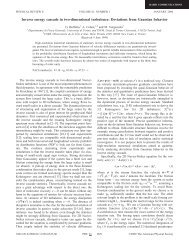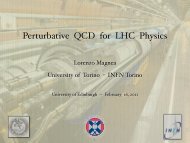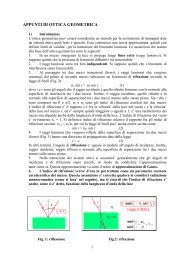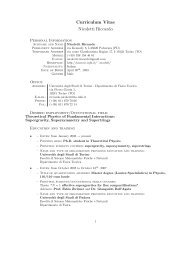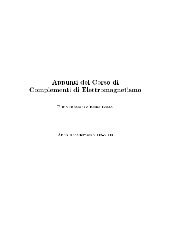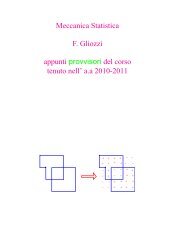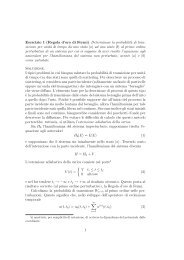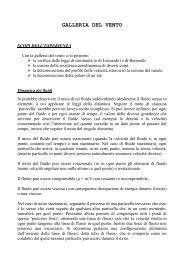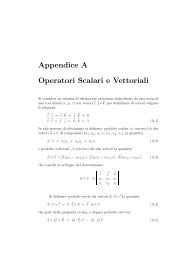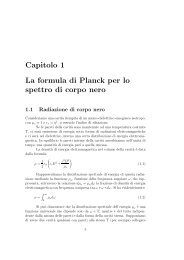Lezioni di Meccanica Quantistica Relativistica A. Bottino e C ... - INFN
Lezioni di Meccanica Quantistica Relativistica A. Bottino e C ... - INFN
Lezioni di Meccanica Quantistica Relativistica A. Bottino e C ... - INFN
Create successful ePaper yourself
Turn your PDF publications into a flip-book with our unique Google optimized e-Paper software.
L’accoppiamento −⃗µ· ⃗B che in teoria <strong>di</strong> Dirac è contenuto nella H int <strong>di</strong> eq.(4.26), in teoria<strong>di</strong> Schrö<strong>di</strong>nger deve essere aggiunto tramite il formalismo <strong>di</strong> spin <strong>di</strong> Pauli. Il valore delrapporto giromagnetico g = 2, trovato nell’ambito della teoria <strong>di</strong> Dirac, è molto prossimoal valore sperimentale. Correzioni al valore g = 2 sono valutabili nella Elettro<strong>di</strong>namica<strong>Quantistica</strong> (QED); all’or<strong>di</strong>ne α si ha[g = 2 1 + α ]. (4.54)2πQuesti effetti sono chiamati “correzioni ra<strong>di</strong>ative”.Con le approssimazioni (4.38), (4.39) l’equazione (4.36) <strong>di</strong>venta(⃗σ · ⃗p − e ⃗ )Aϕ(x) ≃χ(x) . (4.55)2 m4.6 Approssimazione non-relativistica in un campoelettrostaticoConsideriamo l’equazione (4.37) con lo sviluppo (4.40) nel caso A ⃗ = 0:[ () ]12m ⃗σ ·⃗p 1 − E(nr) − e A 0⃗σ ·⃗p + e A 0 χ(x) = E (nr) χ(x) . (4.56)2 mNotiamo che lo sviluppo (4.40) è da interpretarsi come sviluppo in serie nel parametrov 2 /c 2 . Infatti, E (nr) − e A 0 ≃ mv 2 /2, ossia( )E (nr) − e A 0 v2= O . (4.57)m c 2 c 2Se vogliamo stu<strong>di</strong>are termini <strong>di</strong> accoppiamento sino all’or<strong>di</strong>ne (v 2 /c 2 ) 2 , occorre chel’equazione sia riscritta me<strong>di</strong>ante uno spinore a due componenti che, includendo termini<strong>di</strong> or<strong>di</strong>ne v 2 /c 2 , sia normalizzato a uno. Osserviamo ( che per∫ipotesi la funzione d’ondaχrigorosamente normalizzata a uno è la ψ = , ossia dϕ)3 x ψ † ψ = 1. Da questacon<strong>di</strong>zione si ottiene∫1 =d 3 x ( χ † χ + ϕ † ϕ ) ∫≃d 3 xχ † (1 + ⃗p24 m 2 )χ . (4.58)Nell’ultimo passaggio è stata utilizzata la (4.55), che per ⃗ A = 0 <strong>di</strong>ventaϕ(x) ≃⃗σ ·⃗p2 m χ(x) =⇒ ϕ(x) ∼ v χ(x) . (4.59)cQuin<strong>di</strong>, una funzione d’onda spinoriale a due componenti correttamente normalizzata auno, a meno <strong>di</strong> termini <strong>di</strong> or<strong>di</strong>ne superiore a v 2 /c 2 non è la χ, ma la funzione spinorialeX = Ω χ , con Ω = 1 + ⃗p28 m 2 . (4.60)42




